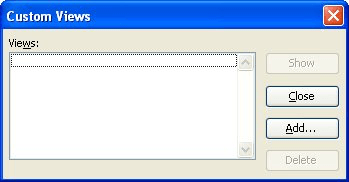Please Note: This article is written for users of the following Microsoft Excel versions: 97, 2000, 2002, and 2003. If you are using a later version (Excel 2007 or later), this tip may not work for you. For a version of this tip written specifically for later versions of Excel, click here: Using Multiple Print Settings.
Written by Allen Wyatt (last updated January 20, 2024)
This tip applies to Excel 97, 2000, 2002, and 2003
If you have multiple areas that you print in a worksheet, you may get tired of repeatedly specifying what area you want to print and then printing it. Such a task is well suited to being done with a macro. The macro can take care of specifying a print area and then actually printing the information.
For instance, let's assume that you have two print ranges defined in your worksheet: Range1 and Range2. Further, Range1 should be printed in portrait orientation and Range2 should be printed in landscape orientation. The following macros can be used to print each of the print ranges:
Sub PrintRange1()
ActiveSheet.PageSetup.PrintArea = Range("range1").Address
ActiveSheet.PageSetup.Orientation = xlPortrait
ActiveWindow.SelectedSheets.PrintOut
End Sub
Sub PrintRange2()
ActiveSheet.PageSetup.PrintArea = Range("range2").Address
ActiveSheet.PageSetup.Orientation = xlLandscape
ActiveWindow.SelectedSheets.PrintOut
End Sub
These are very simple macros, but you get the idea—all you need to do is set up the print job in the macro, and then print from the macro itself. You could even attach the macros to toolbar buttons or to a menu option, as described in other issues of ExcelTips.
If you prefer to not use macros, you could also use the custom views feature of Excel. Simply set the print area, orientation, margins, and other settings desired. Then define this as a custom view. To define a custom view, follow these steps:

Figure 1. The Custom Views dialog box.
You can continue to define and save additional views, as desired. Your custom views are saved with your workbook, and you can later use them to print what you want. (Just display the custom view and then print your worksheet.)
Note:
ExcelTips is your source for cost-effective Microsoft Excel training. This tip (2703) applies to Microsoft Excel 97, 2000, 2002, and 2003. You can find a version of this tip for the ribbon interface of Excel (Excel 2007 and later) here: Using Multiple Print Settings.

Excel Smarts for Beginners! Featuring the friendly and trusted For Dummies style, this popular guide shows beginners how to get up and running with Excel while also helping more experienced users get comfortable with the newest features. Check out Excel 2019 For Dummies today!
Want to make sure that when you worksheet is printed that everything in the workbook is really printed? You can ...
Discover MoreNeed to only print out certain rows from your data? It's easy to do if you apply the filtering or sorting techniques ...
Discover MoreWhen you print out a filtered worksheet, you may want some sort of printed record as to what filtering was applied to the ...
Discover MoreFREE SERVICE: Get tips like this every week in ExcelTips, a free productivity newsletter. Enter your address and click "Subscribe."
There are currently no comments for this tip. (Be the first to leave your comment—just use the simple form above!)
Got a version of Excel that uses the menu interface (Excel 97, Excel 2000, Excel 2002, or Excel 2003)? This site is for you! If you use a later version of Excel, visit our ExcelTips site focusing on the ribbon interface.
FREE SERVICE: Get tips like this every week in ExcelTips, a free productivity newsletter. Enter your address and click "Subscribe."
Copyright © 2026 Sharon Parq Associates, Inc.
Comments